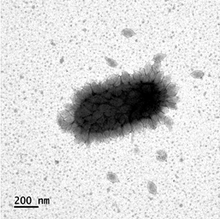
The Campylobacterales are an order of Campylobacterota which make up the epsilon subdivision, together with the small family Nautiliaceae. They are Gram-negative. Most of the species are microaerophilic.
The Thermoprotei is a class of the Thermoproteota.

In the taxonomy of microorganisms, the Methanomicrobia are a class of the Euryarchaeota.
In taxonomy, the Methanococcales are an order of the Methanococci.
Caldisphaeraceae are a family of archaea in the order Acidilobales.
Methanobacteriaceae are a family of archaeans in the order Methanobacteriales.
In taxonomy, the Methanococcaceae are a family of the Methanococcales. These organisms produce methane from formate or through the reduction of carbon dioxide with hydrogen. They live in marshes and other coastal areas. Members of the genus Methanothermococcus have been found in deep-sea hydrothermal vents.

The Nitrososphaerota are a phylum of the Archaea proposed in 2008 after the genome of Cenarchaeum symbiosum was sequenced and found to differ significantly from other members of the hyperthermophilic phylum Thermoproteota. Three described species in addition to C. symbiosum are Nitrosopumilus maritimus, Nitrososphaera viennensis, and Nitrososphaera gargensis. The phylum was proposed in 2008 based on phylogenetic data, such as the sequences of these organisms' ribosomal RNA genes, and the presence of a form of type I topoisomerase that was previously thought to be unique to the eukaryotes. This assignment was confirmed by further analysis published in 2010 that examined the genomes of the ammonia-oxidizing archaea Nitrosopumilus maritimus and Nitrososphaera gargensis, concluding that these species form a distinct lineage that includes Cenarchaeum symbiosum. The lipid crenarchaeol has been found only in Nitrososphaerota, making it a potential biomarker for the phylum. Most organisms of this lineage thus far identified are chemolithoautotrophic ammonia-oxidizers and may play important roles in biogeochemical cycles, such as the nitrogen cycle and the carbon cycle. Metagenomic sequencing indicates that they constitute ~1% of the sea surface metagenome across many sites.
Armatimonadota is a phylum of gram-negative bacteria.
Chloroflexales is an order of bacteria in the class Chloroflexia. The clade is also known as filamentous anoxygenic phototrophic bacteria (FAP), as the order contains phototrophs that do not produce oxygen. These bacteria are facultative aerobic. They generally use chemotrophy when oxygen is present and switch to light-derived energy when otherwise. Most species are heterotrophs, but a few are capable of photoautotrophy.

The Acidimicrobiia are a class of Actinomycetota, in which three families, eight genera, and nine species have been described, Acidimicrobium ferrooxidans is the type species of the order.

Haloferacaceae is a family of halophilic, chemoorganotrophic or heterotrophic archaea within the order Haloferacales. The type genus of this family is Haloferax. Its biochemical characteristics are the same as the order Haloferacales.
Halarchaeum is a genus of halophilic archaea in the family of Halobacteriaceae.
Halonotius is a genus of halophilic archaea in the family of Halorubraceae.
Halogranum is a genus of halophilic archaea in the family of Haloferacaceae.
Halorientalis is a genus of archaea in the family of Haloarculaceae.
Natrialbales is an order of halophilic, chemoorganotrophic archaea within the class Haloarchaea. The type genus of this order is Natrialba.
Halorubraceae is a family of halophilic, chemoorganotrophic or heterotrophic archaea within the order Haloferacales. The type genus of this family is Halorubrum. Its biochemical characteristics are the same as the order Haloferacales.
Haloarchaeobius is a genus of halophilic archaea in the family of Halobacteriaceae.





